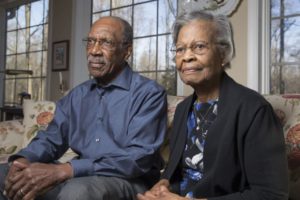
Gladys West (right) and her husband Ira West were fellow mathematicians who worked at the Naval Support Facility Dahlgren. (Photo by Mike Morones/Free Lance-Star)
From cell phones to cars and even social media, most folks in this day and age are familiar with the Geographical Positioning System, or GPS. Little known is the fact that an African–American woman mathematician was a part of the original team of engineers tasked with developing the highly useful system.
“GPS has changed the lives of everyone forever,” Gwen James, a member of Alpha Kappa Alpha Sorority, Inc., said upon learning her longtime soror Gladys West played a “pivotal” role in creating the now-household technology.
“There isn’t a segment of this global society — military, auto industry, cell phone industry, social media, parents, NASA, etc. — that doesn’t utilize the Global Positioning System,” she told the Free Lance-Star.
West, 87, enjoyed a 42-year career as a mathematician at the Naval Support Facility in Dahlgren, Va., where she, and fellow engineers saw the early beginnings of the popular tracking system. She was just one of four Black Americans employed at the Naval base when she first started in 1956, her calculations eventually leading to satellites. A year later West married Ira West, a fellow mathematician she met at the Naval facility.
James said she was totally unaware her soror was one of the “Hidden Figures” behind GPS until she read her biography for an event honoring senior members of her sorority. Now, she wanted to share West’s accomplishments with the rest of the world.
“I think her story is amazing,” James said.
West herself said she had no idea her time spent recording satellite locations would impact so many people years later. To her, she was simply doing her job.
“When you’re working every day, you’re not thinking, ‘What impact is this going to have on the world?’ ” she told the Free Lance-Star. “You’re thinking, ‘I’ve got to get this right.’ ”
According to the newspaper, West collected data from the orbiting machines, honing in on information that helped her determine their exact locations as they communicated across the world. That data was then entered into so-called “supercomputers” while she worked on computer software designed to measure precise surface elevations.
In a nutshell, West said her calculations took a great deal of time, as she was checking and double-checking equations and worked to collect and analyze troves of data. She insists the work was rewarding, however.
“I was ecstatic,” West said. “I was able to come from Dinwiddie County and be able to work with some of the greatest scientists working on these projects.”
When it comes to traveling, the seasoned mathematician surprisingly prefers a paper map over the tracking system, as some of the data points could be outdated from the time she worked on the equations, her daughter told the newspaper.
To this day, she still does her own calculations.
